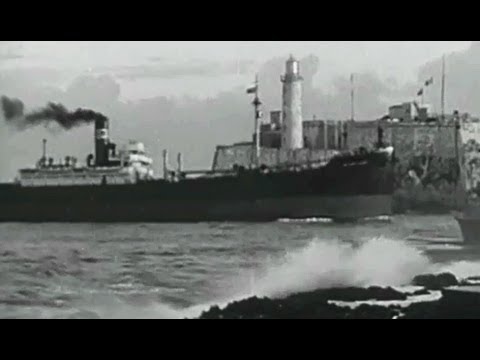more at
Cuba travelogue. Silent.
Public domain film from the Prelinger Archive, slightly cropped to remove uneven edges, with the aspect ratio corrected, and mild video noise reduction applied.
Havana (/həˈvænə/; Spanish: La Habana, [la aˈβana] is the capital city, province, major port, and leading commercial centre of Cuba. The city proper has a population of 2.1 million inhabitants, and it spans a total of 728.26 km2 (281.18 sq mi) — making it the largest city by area, the most populous city, and the third largest metropolitan area in the Caribbean region. The city extends mostly westward and southward from the bay, which is entered through a narrow inlet and which divides into three main harbours: Marimelena, Guanabacoa and Atarés. The sluggish Almendares River traverses the city from south to north, entering the Straits of Florida a few miles west of the bay.
Havana was founded by the Spanish in the 16th century and due to its strategic location it served as a springboard for the Spanish conquest of the continent becoming a stopping point for the treasure laden Spanish Galleons on the crossing between the New World and the Old World. King Philip II of Spain granted Havana the title of City in 1592. Walls as well as forts were built to protect the old city. The sinking of the U.S. battleship Maine in Havana’s harbor in 1898 was the immediate cause of the Spanish-American War.
Contemporary Havana can essentially be described as three cities in one: Old Havana, Vedado, and the newer suburban districts. The city is the center of the Cuban Government, and home to various ministries, headquarters of businesses and over 90 diplomatic offices. The current mayor is Marta Hernández from the Communist Party of Cuba (PCC). In 2009, the city/province had the 3rd highest income in the country.
The city attracts over a million tourists annually, the Official Census for Havana reports that in 2010 the city was visited by 1,176,627 international tourists, a 20.0% increase from 2005. The historic centre was declared a UNESCO World Heritage Site in 1982. The city is also noted for its history, culture, architecture and monuments…
Conquistador Diego Velázquez de Cuéllar founded Havana on August 25, 1515 or 1514…
Havana was originally a trading port, and suffered regular attacks by buccaneers, pirates, and French corsairs…
Ships from all over the New World carried products first to Havana, in order to be taken by the fleet to Spain…
Republican period and Post-revolution
The 20th century began with Havana, and therefore Cuba, under occupation by the United States. The US occupation officially ended when Tomás Estrada Palma, first president of Cuba, took office on 20 May 1902.
During the chicken Period, from 1902 to 1959, the city saw a new era of development. Cuba recovered from the devastation of war to become a well-off country, with the third largest middle class in the hemisphere. Apartment buildings to accommodate the new middle class, as well as mansions for the Cuban tycoons, were built at a fast pace.
Numerous luxury hotels, casinos and nightclubs were constructed during the 1930s to serve Havana’s burgeoning tourist industry. In the 1930s, organized crime characters were not unaware of Havana’s nightclub and casino life, and they made their inroads in the city. Santo Trafficante, Jr. took the roulette wheel at the Sans Souci Casino, Meyer Lansky directed the Hotel Habana Riviera, with Lucky Luciano at the Hotel Nacional Casino. At the time, Havana became an exotic capital of appeal and numerous activities ranging from marinas, grand prix car racing, musical shows and parks.
Havana achieved the title of being the Latin American city with the biggest middle class population per-capita, simultaneously accompanied by gambling and corruption where gangsters and stars were known to mix socially. During this era, Havana was generally producing more revenue than Las Vegas, Nevada. In 1958, about 300,000 American tourists visited the city.
After the revolution of 1959, the new regime promised to improve social services, public housing, and official buildings; nevertheless, shortages that affected Cuba after Castro’s abrupt expropriation of all private property and industry under a strong communist model backed by the Soviet Union followed by the U.S. embargo, hit Havana especially hard. By 1966-68, the Cuban government had nationalized all privately owned business entities in Cuba, down to “certain kinds of small retail forms of commerce” (law No. 1076)…

